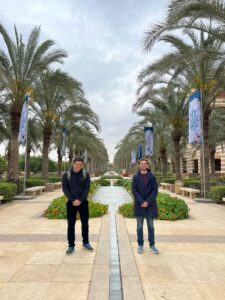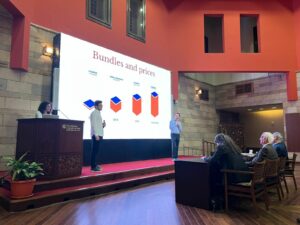Valorizing rice farming waste in Egypt: Samuel OHAYON rewarded for his innovative project
Like every year, Cairo University in Egypt organized the Real Life Innovation Competition, open to students from all over the world. Samuel OHAYON, a student in Master in Entrepreneurship & Innovation at IÉSEG, won this international competition for his project of revalorization of the waste produced by rice growing in Egypt for the benefit of the Supply Chain industry. He explains his project, the competition and what it meant to him in the context of his studies.
How did you end up participating in the Real Life Innovation Competition at Cairo University in Egypt? Can you tell us more about this event?
As a member of the Babson Collaborative Student Network (BCSN) Steering Committee, I am very aware of what is happening in the world of entrepreneurship. BCSN student ambassadors are chosen to represent their school and have the opportunity to engage in a global network of peers, learn about entrepreneurship, culture, arts… from different perspectives and develop leadership skills while organizing events for a broader student audience.
When I heard about the Real Life Innovation Competition, an international challenge organized every year by students from the prestigious Cairo University, I was immediately interested. It’s a big event, gathering almost 100 teams from all over the world. It’s an innovation competition in the broad sense of the word, but ultimately it’s also an entrepreneurial competition because the “feasibility” of the proposed project is also very important. So, I looked for other students who would be willing to participate with me. After posting an ad, I found a Colombian teammate and an Egyptian student, who joined me directly in Egypt where I stayed 10 days to work with them on our innovative project.
What project did you submit that made you win the prize in this competition in Egypt?
 First of all, I think it’s important to mention that this competition focuses on three areas: efficient consumption and production; sustainable agriculture; and financial inclusion. In our case, we focused on the first two axes. To explain our project, we need to go back to the original problem: in Egypt, 5 million tons of rice are produced per year, and this generates 3.5 million tons of waste called “rice straw”. This rice straw takes up a lot of space and farmers, not knowing what to do with this waste, burn it on their fields. This has harmful consequences: deterioration of their fields, creation of pollution clouds over Cairo… The situation is therefore critical from an environmental point of view. The government has tried to ban this practice but nothing is done because farmers have no alternatives. On the other hand, (and this is seemingly unrelated) supply crates have seen their price increase by 68% in one year due to the rise in wood and labor prices. So we decided to reconcile these two seemingly unrelated issues by creating a new material from rice straw with a local engineer. The idea is to make supply boxes from this material that we have created, and which is both anti-moth and anti-mold. This material allows us to offer cheaper boxes than those made with wood. Thanks to an IoT system, we will also be able to track these boxes in real-time around the world, as well as the conditions of the box (such as the humidity level inside, when they have been opened…). A subscription model will be proposed for data collection and analysis. It is thus a complete system that we presented to the competition jury.
First of all, I think it’s important to mention that this competition focuses on three areas: efficient consumption and production; sustainable agriculture; and financial inclusion. In our case, we focused on the first two axes. To explain our project, we need to go back to the original problem: in Egypt, 5 million tons of rice are produced per year, and this generates 3.5 million tons of waste called “rice straw”. This rice straw takes up a lot of space and farmers, not knowing what to do with this waste, burn it on their fields. This has harmful consequences: deterioration of their fields, creation of pollution clouds over Cairo… The situation is therefore critical from an environmental point of view. The government has tried to ban this practice but nothing is done because farmers have no alternatives. On the other hand, (and this is seemingly unrelated) supply crates have seen their price increase by 68% in one year due to the rise in wood and labor prices. So we decided to reconcile these two seemingly unrelated issues by creating a new material from rice straw with a local engineer. The idea is to make supply boxes from this material that we have created, and which is both anti-moth and anti-mold. This material allows us to offer cheaper boxes than those made with wood. Thanks to an IoT system, we will also be able to track these boxes in real-time around the world, as well as the conditions of the box (such as the humidity level inside, when they have been opened…). A subscription model will be proposed for data collection and analysis. It is thus a complete system that we presented to the competition jury.
How did the Real Life Innovation Competition work?
There were three stages during which we pitched our project. In the final phase, only 5 teams were left. Throughout the competition, we were able to talk to experts from different fields at Cairo University. We received positive feedback from them. We also learned that many people are trying to solve this rice straw problem by coming up with solutions that are sustainable but not profitable, which is obviously a problem for their launch. So, the juries were particularly attracted to our solution, which is ingenious both technologically and in terms of business because there is tremendous profit potential. In addition, this solution can be produced locally and will thus bring sovereignty to this industry.
What exactly are you looking for when participating in this kind of competition?
 I would like to participate in other competitions to determine which project will make the most sense to implement. I’ve always dreamed of being an inventor since I was little, and these competitions allow me to give free rein to my creativity in order to respond to specific problems. It is also an asset for my CV because it allows me to support the innovative side I put forward. You can’t claim to be innovative without supporting evidence. The competition is also an opportunity to meet people with similar interests to mine, who are motivated and have a sense of innovation and work well done.
I would like to participate in other competitions to determine which project will make the most sense to implement. I’ve always dreamed of being an inventor since I was little, and these competitions allow me to give free rein to my creativity in order to respond to specific problems. It is also an asset for my CV because it allows me to support the innovative side I put forward. You can’t claim to be innovative without supporting evidence. The competition is also an opportunity to meet people with similar interests to mine, who are motivated and have a sense of innovation and work well done.
Winning the Real Life Innovation Competition this year confirmed that my idea was good and viable. Indeed, it is important to have innovative ideas, but it is also necessary to have the confirmation that they are of interest to your target before implementing them. It also gave me a boost of motivation to continue to innovate with other projects and participate in other competitions!pour continuer d’innover avec d’autres projets et participer à d’autres compétitions !
What did you learn from this experience in Egypt?
In Egypt, I noticed a lot of social and environmental problems. In general, there is a great lack of optimization. When I saw this, I realized that innovating in France was not really the most interesting thing because in the end, in my opinion, it is mostly a question of outbidding. Indeed, we bring a “disruptive” idea on top of an already disruptive innovation, which will simply bring an increase in profit or a minimal improvement from an environmental point of view. I think that if we want to help the planet in any way, we must go to countries like Egypt to come up with real virtuous models that will make a real difference. By acting there, we can start from scratch, whereas in France, for example, we already have a huge base that does not allow us to truly change the situation.



